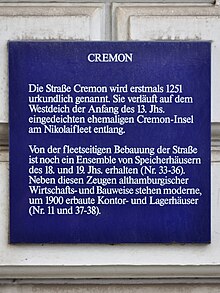Cremon

Cremon is the name of a street in Hamburg's old town and originally referred to a marsh island in the area where the Alster flows into the Elbe . The origin of the name is unclear, possibly it goes back to a former resident. According to another interpretation, the name can be derived from "a crooked moon, because of the similarity of the street with the crescent-shaped moon quarter". The street name has existed as Cremun since at least 1251 , and in 1289 it is listed in a document as platea Crymon .
The Cremon Island encompassed the area of today's streets Cremon, Katharinenstraße, Katharinenfleet, Steckelhörn and Bei den Mühren and was assigned to the first settlers in what was then Neustadt (not to be confused with today's Hamburg-Neustadt district ) as a pasture area outside the city walls . A ring dike was built around the houses ; the land was divided into narrow, deep plots on which the typical old Hamburg town house developed. Each plot of land had access to the main runoff of the Alster into the Elbe, the later Nikolaifleet . The Katharinenfleet was built behind the houses in the Middle Ages , but after the Second World War in 1946 it was filled in, as was the Steckelhörnfleet , which separated the Cremon Island from the neighboring island of Grimm .
Cremon came directly to the city of Hamburg in 1246 and, together with the Grimm, formed the parish of the newly built Katharinenkirche .
In 1937, the Cremon, which had survived the Hamburg fire of 1842 and almost a hundred years of urban renewal, was to be preserved as a traditional Hanseatic island . The first restoration work began in 1937, but the air raid on Hamburg in 1943 destroyed the entire area. Today, only the outer dyke houses Cremon 33 to 36 between the street and the Fleet are the last old Hamburg warehouses from the 18th and early 19th centuries.
From the house Cremon 28, a former warehouse building, there is a tympanum as an architectural fragment on the north facade of the Hamburg Museum . On the tympanum is the head of Mercury , the Roman messenger of the gods and god of merchants and thieves, as an allusion to the economic use of the former building. The granary was built in 1789 by the architect PJ Wittgreff, who presumably also created the tympanum.
Johann Theobald Riefesell : Portal of the House of Cremon 27 (between 1882 and 1894)
Half-timbered house Cremon 34 as seen from Nicolaifleet
literature
- Daniel Tilgner: Cremon . In: Franklin Kopitzsch , Daniel Tilgner (Ed.): Hamburg Lexikon . Ellert and Richter, Hamburg 2010, ISBN 978-3-8319-0373-3 , pp. 152-153 .
- Jonas-Ludwig von Hess: Hamburg described topographically, politically and historically . 2nd Edition. Printed by JC Brüggemann, Hamburg 1810, p. 386 .
Web links
Individual evidence
- ^ Jonas Ludwig von Heß : Hamburg described topographically, politically and historically . Printed by JC Brüggemann in 1810, 2nd edition, p. 386
Coordinates: 53 ° 32 ′ 44 ″ N , 9 ° 59 ′ 18 ″ E




